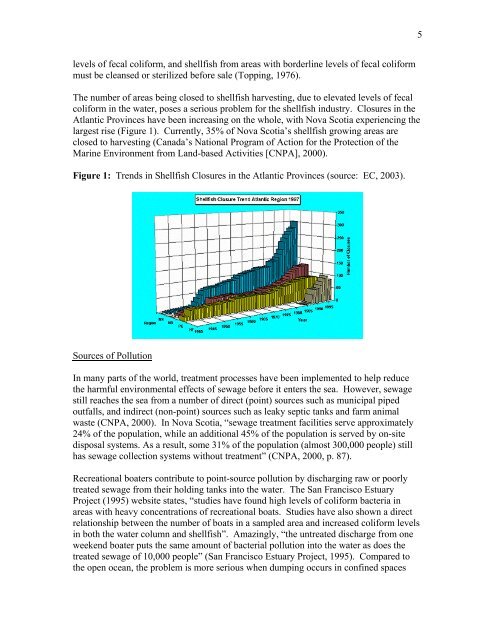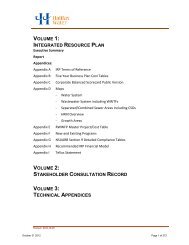Pollution and Coastal Zone Management: A Case Study - Halifax ...
Pollution and Coastal Zone Management: A Case Study - Halifax ...
Pollution and Coastal Zone Management: A Case Study - Halifax ...
You also want an ePaper? Increase the reach of your titles
YUMPU automatically turns print PDFs into web optimized ePapers that Google loves.
5<br />
levels of fecal coliform, <strong>and</strong> shellfish from areas with borderline levels of fecal coliform<br />
must be cleansed or sterilized before sale (Topping, 1976).<br />
The number of areas being closed to shellfish harvesting, due to elevated levels of fecal<br />
coliform in the water, poses a serious problem for the shellfish industry. Closures in the<br />
Atlantic Provinces have been increasing on the whole, with Nova Scotia experiencing the<br />
largest rise (Figure 1). Currently, 35% of Nova Scotia’s shellfish growing areas are<br />
closed to harvesting (Canada’s National Program of Action for the Protection of the<br />
Marine Environment from L<strong>and</strong>-based Activities [CNPA], 2000).<br />
Figure 1: Trends in Shellfish Closures in the Atlantic Provinces (source: EC, 2003).<br />
Sources of <strong>Pollution</strong><br />
In many parts of the world, treatment processes have been implemented to help reduce<br />
the harmful environmental effects of sewage before it enters the sea. However, sewage<br />
still reaches the sea from a number of direct (point) sources such as municipal piped<br />
outfalls, <strong>and</strong> indirect (non-point) sources such as leaky septic tanks <strong>and</strong> farm animal<br />
waste (CNPA, 2000). In Nova Scotia, “sewage treatment facilities serve approximately<br />
24% of the population, while an additional 45% of the population is served by on-site<br />
disposal systems. As a result, some 31% of the population (almost 300,000 people) still<br />
has sewage collection systems without treatment” (CNPA, 2000, p. 87).<br />
Recreational boaters contribute to point-source pollution by discharging raw or poorly<br />
treated sewage from their holding tanks into the water. The San Francisco Estuary<br />
Project (1995) website states, “studies have found high levels of coliform bacteria in<br />
areas with heavy concentrations of recreational boats. Studies have also shown a direct<br />
relationship between the number of boats in a sampled area <strong>and</strong> increased coliform levels<br />
in both the water column <strong>and</strong> shellfish”. Amazingly, “the untreated discharge from one<br />
weekend boater puts the same amount of bacterial pollution into the water as does the<br />
treated sewage of 10,000 people” (San Francisco Estuary Project, 1995). Compared to<br />
the open ocean, the problem is more serious when dumping occurs in confined spaces

















